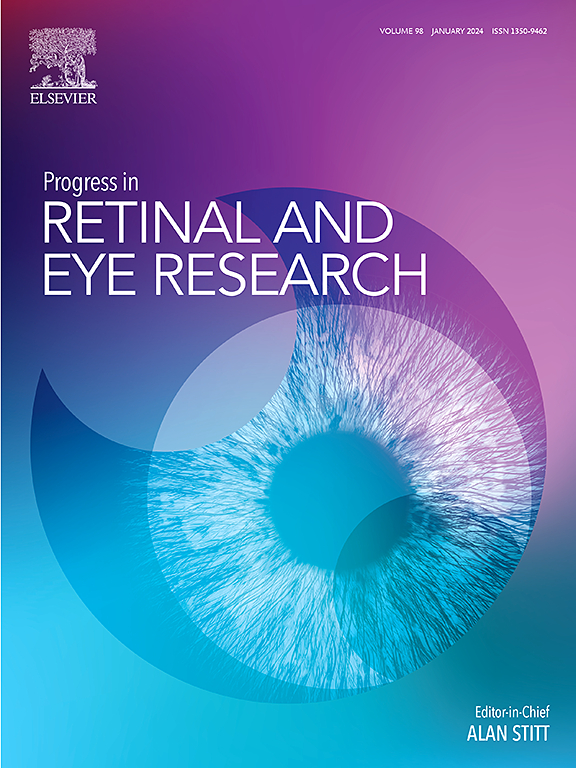厚脉络膜疾病谱:多模态成像和OCT血管造影如何提高我们的知识。
IF 14.7
1区 医学
Q1 OPHTHALMOLOGY
引用次数: 0
摘要
厚脉络膜谱系疾病(psd)是一组以脉络膜异常增厚和脉络膜、视网膜色素上皮和视网膜的各种病理改变为特征的脉络膜视网膜疾病。本文综述了目前多模态成像技术在psd诊断和治疗中的应用。我们研究了各种成像方式的作用,包括光学相干断层扫描(OCT)、OCT血管造影(OCTA)、表面OCT、荧光素血管造影(FA)、吲哚菁绿血管造影(ICGA)、红外成像(IR)和眼底自身荧光(FAF)在评估psd中的作用。每种成像方式都提供了独特的见解:OCT显示特征性脉络膜增厚和结构变化;OCTA显示脉络膜血流和新生血管的改变;正面OCT可以详细显示脉络膜血管系统和漩涡间吻合;FA显示渗漏模式;ICGA显示脉络膜高通透性和血管粗大;红外成像有助于RPE评估;FAF则突出了RPE功能障碍。这些成像技术的整合增强了我们对psd病理生理学的理解,提高了我们诊断、监测和治疗这些疾病的能力。这篇综述特别强调了OCTA如何提高了我们对psd脉络膜循环和新生血管的认识。我们还讨论了成像技术的未来方向及其对个性化治疗方法的潜在影响,包括基于成像生物标志物的优化光动力治疗。多模态成像的协同使用是psd管理的基石,可以实现更精确的诊断和量身定制的治疗策略。本文章由计算机程序翻译,如有差异,请以英文原文为准。
Pachychoroid disease spectrum: how multimodal imaging and OCT angiography have improved our knowledge
Pachychoroid spectrum disorders (PSDs) represent a group of chorioretinal disorders characterized by abnormal choroidal thickening and various pathological changes in the choroid, retinal pigment epithelium, and retina. This review provides a comprehensive analysis of current multimodal imaging techniques in the diagnosis and management of PSDs. We examine the role of various imaging modalities including optical coherence tomography (OCT), OCT angiography (OCTA), en face OCT, fluorescein angiography (FA), indocyanine green angiography (ICGA), infrared imaging (IR), and fundus autofluorescence (FAF) in evaluating PSDs. Each imaging modality provides unique insights: OCT reveals characteristic choroidal thickening and structural changes; OCTA demonstrates alterations in choroidal flow and neovascularization; en face OCT allows detailed visualization of choroidal vasculature and intervortex anastomoses; FA shows patterns of leakage; ICGA reveals choroidal hyperpermeability and pachyvessels; IR imaging assists in RPE evaluation; and FAF highlights RPE dysfunction. The integration of these imaging techniques has enhanced our understanding of the pathophysiology of PSDs and improved our ability to diagnose, monitor, and treat these conditions. This review particularly emphasizes how OCTA has advanced our knowledge of choroidal circulation and neovascularization in PSDs. We also discuss future directions in imaging technology and their potential impact on personalized therapeutic approaches, including optimized photodynamic therapy based on imaging biomarkers. The synergistic use of multimodal imaging represents a cornerstone in the management of PSDs, enabling more precise diagnosis and tailored treatment strategies.
求助全文
通过发布文献求助,成功后即可免费获取论文全文。
去求助
来源期刊
CiteScore
34.10
自引率
5.10%
发文量
78
期刊介绍:
Progress in Retinal and Eye Research is a Reviews-only journal. By invitation, leading experts write on basic and clinical aspects of the eye in a style appealing to molecular biologists, neuroscientists and physiologists, as well as to vision researchers and ophthalmologists.
The journal covers all aspects of eye research, including topics pertaining to the retina and pigment epithelial layer, cornea, tears, lacrimal glands, aqueous humour, iris, ciliary body, trabeculum, lens, vitreous humour and diseases such as dry-eye, inflammation, keratoconus, corneal dystrophy, glaucoma and cataract.

 求助内容:
求助内容: 应助结果提醒方式:
应助结果提醒方式:


